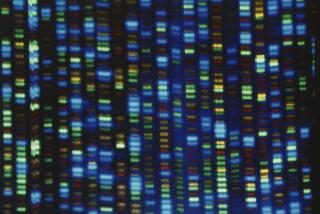Virginia Sets Up Police Library of Gene Prints
- Share via
RICHMOND, Va. — Virginia is going to have the first state laboratory in the nation with a data bank of genetic prints, which enable police to identify criminals from scanty physical evidence, such as saliva left at a crime scene.
The Virginia Division of Consolidated Laboratory Services will provide DNA testing for the state’s police and sheriff’s departments beginning May 1.
DNA testing is “the most significant development for law enforcement since fingerprinting, and that dates back about 100 years,” said Paul B. Ferrara, director of the state Bureau of Forensic Science.
The lab will develop a computerized library of DNA prints from known sex offenders in the state.
A state law passed last month requires sex offenders to give blood samples. DNA, or deoxyribonucleic acid, is found in the chromosomes of cells from saliva, hair, blood, semen, tissue and bone marrow. Only identical twins can have the same DNA pattern, or genetic blueprint.
Genetic Blueprint
Scientists in recent years have developed technology for taking DNA from body fluids or from tissue left at a crime scene, and matching it with the genetic blueprint of a suspect.
“If a rapist leaves seminal fluid at the scene . . . he might as well be leaving his Social Security card,” Ferrara said.
He said DNA testing already has helped to solve one case in Virginia. Timothy Spencer, of Richmond, was convicted of three capital murders on the basis of genetic printing.
“I’m not a lawyer, but, based on what I’ve been told, Timothy Spencer probably never would have been convicted without the DNA testing,” Ferrara said. The case is under review by the state Supreme Court.
Ferrara said DNA testing also could serve as a crime deterrent. He said criminals can be careful not to leave fingerprints, as Spencer was, but the chances of committing a violent crime without leaving any source of a DNA sample are slim.
Previously, analysis of body fluids, tissue or hair left at crime scenes consisted of examining enzymes and blood types--processes that could eliminate a suspect but could not positively identify the guilty party.
‘Like Fingerprints’
“Conventional serologic evidence was always circumstantial,” Ferrara said. “You could say that a particular sample could have come from, say, 13% of the male population, but with DNA testing you can say this sample definitely came from that person. It’s just like fingerprints in that respect.”
DNA is inherited, half from each parent. For about 10 years, scientists have used DNA testing to determine paternity and to study genetically related diseases.
About three years ago, DNA testing was first used to solve a rape in a small town in England, Ferrara said. The technology has since been used to solve several crimes in the United States, but Virginia is one of the first states to begin collecting samples on a broad scale.
More to Read
Sign up for Essential California
The most important California stories and recommendations in your inbox every morning.
You may occasionally receive promotional content from the Los Angeles Times.













